PPAR α Targeting GDF11 Inhibits Vascular Endothelial Cell Senescence in an Atherosclerosis Model
- PMID: 33728018
- PMCID: PMC7935606
- DOI: 10.1155/2021/2045259
PPAR α Targeting GDF11 Inhibits Vascular Endothelial Cell Senescence in an Atherosclerosis Model
Abstract
Atherosclerosis (AS) is a complex vascular disease that seriously harms the health of the elderly. It is closely related to endothelial cell aging, but the role of senescent cells in atherogenesis remains unclear. Studies have shown that peroxisome proliferator-activated receptor alpha (PPARα) inhibits the development of AS by regulating lipid metabolism. Our previous research showed that PPARα was involved in regulating the repair of damaged vascular endothelial cells. Using molecular biology and cell biology approaches to detect senescent cells in atherosclerosis-prone apolipoprotein E-deficient (Apoe -/-) mice, we found that PPARα delayed atherosclerotic plaque formation by inhibiting vascular endothelial cell senescence, which was achieved by regulating the expression of growth differentiation factor 11 (GDF11). GDF11 levels declined with age in several organs including the myocardium, bone, central nervous system, liver, and spleen in mice and participated in the regulation of aging. Our results showed that PPARα inhibited vascular endothelial cell senescence and apoptosis and promoted vascular endothelial cell proliferation and angiogenesis by increasing GDF11 production. Taken together, these results demonstrated that PPARα inhibited vascular endothelial cell aging by promoting the expression of the aging-related protein GDF11, thereby delaying the occurrence of AS.
Copyright © 2021 Fangfang Dou et al.
Conflict of interest statement
The authors declare no conflicts of interest.
Figures
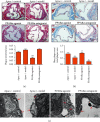
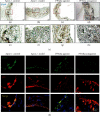
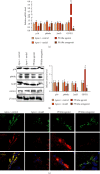
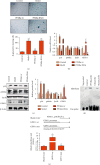
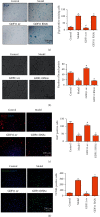
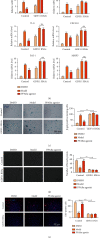
Similar articles
-
The dual PPARα/γ agonist aleglitazar increases the number and function of endothelial progenitor cells: implications for vascular function and atherogenesis.Br J Pharmacol. 2014 May;171(10):2685-703. doi: 10.1111/bph.12608. Br J Pharmacol. 2014. PMID: 24467636 Free PMC article.
-
Peroxisome proliferator-activated receptor-alpha gene level differently affects lipid metabolism and inflammation in apolipoprotein E2 knock-in mice.Arterioscler Thromb Vasc Biol. 2011 Jul;31(7):1573-9. doi: 10.1161/ATVBAHA.110.220525. Epub 2011 Apr 7. Arterioscler Thromb Vasc Biol. 2011. PMID: 21474829 Free PMC article.
-
TERT assists GDF11 to rejuvenate senescent VEGFR2+/CD133+ cells in elderly patients with myocardial infarction.Lab Invest. 2019 Nov;99(11):1661-1688. doi: 10.1038/s41374-019-0290-1. Epub 2019 Jul 10. Lab Invest. 2019. PMID: 31292540
-
Molecular mechanisms and therapeutic perspectives of peroxisome proliferator-activated receptor α agonists in cardiovascular health and disease.Med Res Rev. 2023 Nov;43(6):2086-2114. doi: 10.1002/med.21970. Epub 2023 Apr 29. Med Res Rev. 2023. PMID: 37119045 Review.
-
Vascular Diseases and Gangliosides.Int J Mol Sci. 2019 Dec 17;20(24):6362. doi: 10.3390/ijms20246362. Int J Mol Sci. 2019. PMID: 31861196 Free PMC article. Review.
Cited by
-
Factors and Pathways Modulating Endothelial Cell Senescence in Vascular Aging.Int J Mol Sci. 2022 Sep 4;23(17):10135. doi: 10.3390/ijms231710135. Int J Mol Sci. 2022. PMID: 36077539 Free PMC article. Review.
-
How PPAR-alpha mediated inflammation may affect the pathophysiology of chronic kidney disease.Curr Res Physiol. 2024 Nov 14;8:100133. doi: 10.1016/j.crphys.2024.100133. eCollection 2025. Curr Res Physiol. 2024. PMID: 39665027 Free PMC article. Review.
-
Correlation Between GDF11 Serum Levels, Severity of Coronary Artery Lesions, and the Prognosis of Patients with ST-segment Elevation Myocardial Infarction.J Cardiovasc Transl Res. 2023 Aug;16(4):938-947. doi: 10.1007/s12265-023-10358-w. Epub 2023 Feb 7. J Cardiovasc Transl Res. 2023. PMID: 36749564
-
Peroxisome Proliferator-Activated Receptor α/γ and Cannabinoid Receptor 2 Agonist Attenuated Nonalcoholic Steatohepatitis Exosome-Related Abnormalities in Mice.Am J Pathol. 2025 Feb;195(2):188-203. doi: 10.1016/j.ajpath.2024.10.006. Epub 2024 Oct 26. Am J Pathol. 2025. PMID: 39490440
-
Mechanisms and consequences of endothelial cell senescence.Nat Rev Cardiol. 2023 Jan;20(1):38-51. doi: 10.1038/s41569-022-00739-0. Epub 2022 Jul 19. Nat Rev Cardiol. 2023. PMID: 35853997 Free PMC article. Review.
References
MeSH terms
Substances
LinkOut - more resources
Full Text Sources
Other Literature Sources
Medical
Research Materials
Miscellaneous

